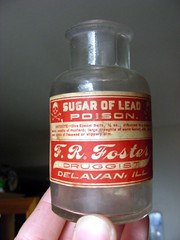My youngest son, Barnacle Boy, swims like a fish. When he was small, he could stay under water just a second longer than I though he should be able to -- I'd be ready to reach under and haul him to the surface, and then up he would pop. I began to wonder if he had gills.
Nowadays I'm certain he has no gills, though he can still hold his breath for a long time. He's not quite completely adapted to an aquatic life, though. He suffers from water in the ears. And he hates to hear himself sloshing...
The standard remedy for water stuck in the ears is "SwimEar" - an ad for which reads in part:
"Once water enters this tube...surface tension will cause this water to adhere firmly to the walls of the canal, thereby blocking it. Why is this water so difficult to remove? This is due to surface tension effect as well as the fact that it is extremely difficult to break the vacuum that is created behind the trapped water in the ear canal."
Despite the popping sensation you can get when your ears finally clear from water, there is no vacuum behind the water (really, I'm certain). As the ad implies, the trouble is that water is clingy, and therefore has a high surface tension. The high surface tension is what impedes the flow of water out of the ear canal -- think of getting the water out of a thin straw. The ear canal is behaving like a capillary. Reduce the surface tension and the fluid will release.
SwimEar is just a solution of isopropyl alcohol with a dash of glycerin added for comfort. (Ethanol, or ethyl alcohol, is what we drink - but to a chemist, an alcohol is a molecule that has a "tail" of (mostly) carbons and hydrogens topped off by a hydroxyl group: OH. Ethanol is CH3CH2OH, isopropyl alcohol is (CH3)2CHOH.) The isopropyl alcohol lowers the surface tension of the water (so will a bit of soapy water for that matter).
Change of address
5 months ago in Variety of Life

















